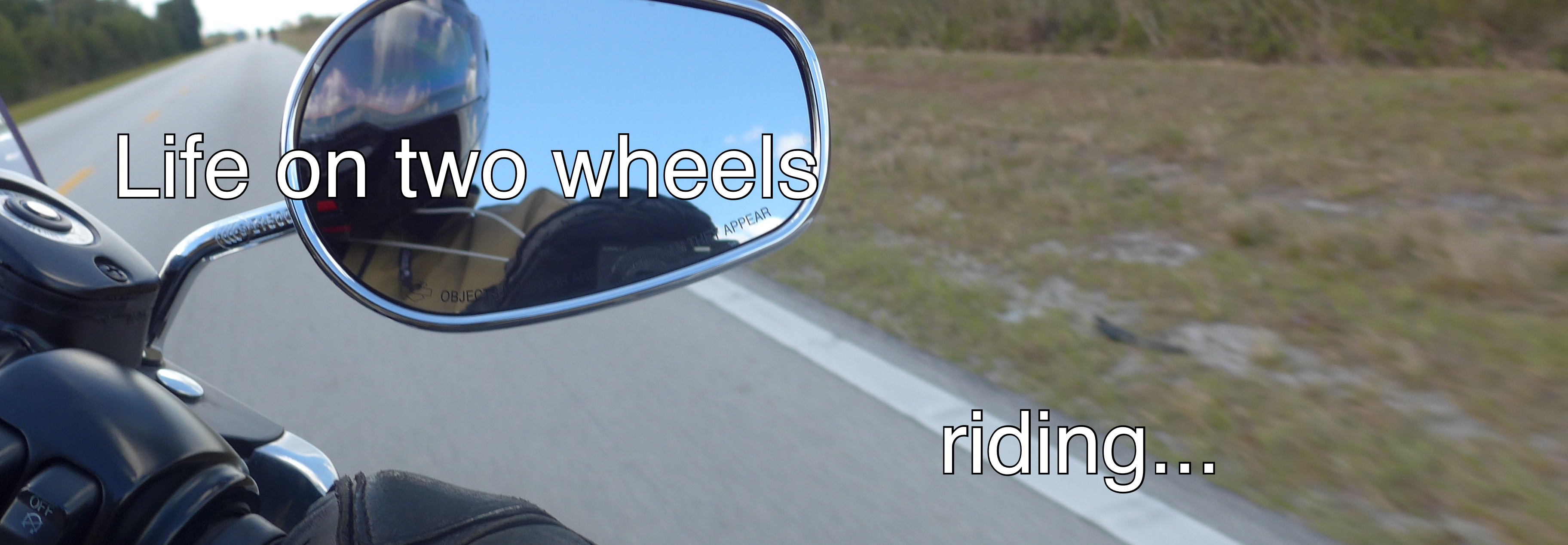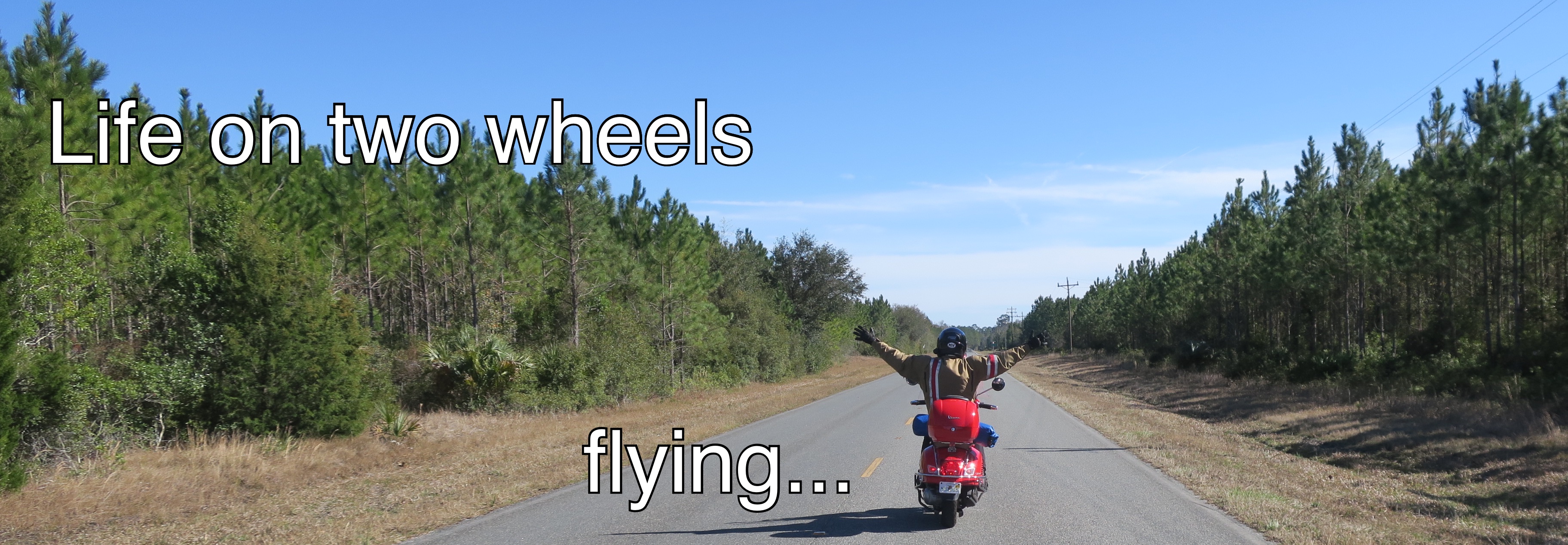At long last, after threatening to post all the things I've learned since I first began this magnificent adventure back in February of 2010, here I go.
I don't know if there is a limit to how much stuff you're allowed to cram into a blogger post, but if there is a limit, I may well find out what it is. Here are 58 things I learned during my first scooter commuting season. One for each year I've lived. Who would have thunk?
1. Feet on the passenger pegs
After experimenting with various slightly different seating positions over the riding season, I've found that placing my feet more rearward, basically on the rear passenger footpegs, instead of forward close to the legshield, is i) more comfortable, ii) gives me a better feeling of control, and iii) allows me to "post" over obstacles (see the next topic).
2. Posting over tracks and bumps
When I was a kid my mom insisted I take formal horseback riding lessons. English saddle and such. I quickly learned that horses were way too big, and a lot less fun for me than for the Lone Ranger on TV. For the longest time I figured that those lessons were wasted on me. And then, 50 years later, it turns out that "posting" (raising your bum off the saddle to avoid bouncing around when the horse trots) is really useful on a scooter when there are obstacles (such as train tracks and potholes) to cross, of which my scoot commute route offers many. You get much better control, and deliver much less punishment to the scooter. Especially if you weigh 200 lbs.
3. Seams in the pavement: not really a big deal
Way back in April, when I began commuting, I spent too much time worrying about and looking out for seams in the pavement. Especially those seams covered with that rubbery, tarry, crack filler stuff that seems to have gotten popular, at least around here. As my experience increased, and as I got way more serious about tire pressure (see tire pressure below), seams in the road turned out to be not a real concern. Sometimes you get a little squirm, but overall, not something to be so worried about.
4. Edge traps and driveway entrances
If seams are no big deal, bona fide edge traps are to be taken seriously. Read about edge traps in David Hough's Proficient Motorcycling. When you have to cross an edge trap, for instance when you turn into a parking lot and have to use a sidewalk ramp, make sure that you cross the line at least at 45 degrees. Anything less, and you might loose control, perhaps drop the bike. For railroad tracks or streetcar tracks that cross the road at 45 degrees, watch out in the rain. The rails are slick, and the aprons that some crossings have are slick as well.
5. Bag on the parcel hook
I tried several ways of carrying my computer bag. Wearing it across your chest with the bag on the passenger seat is only advisable for really short hops. It's guaranteed to give you a pain in the neck (and shoulder too) if you try to commute that way. For the better part of the spring and summer I used a bungee net to secure the bag to the passenger seat. That works very well, and in fact, a bungee net (about $10) is a must have in your topcase, pet carrier or glove box. In the end though I found that the parcel hook was the best way for me. I found it held the bag very securely, much more so than I thought, and it saved me precious time not fiddling with the bungee net, and even more time when I needed to get gas. So get a bungee net by all means, but carry your laptop on the parcel hook. That's what first got me using those rear footpegs. Win - Win!!
6. How to pump gas
This I learned in part from the amazing folks at Modern Vespa, and in part from Pierre, the most experienced and knowledgeable PTW rider I have met so far. Insert the nozzle fully into the gas tank, facing the rear of the tank, not the side of the tank, which seems the most natural way to pump gas, or the front or the tank (as you might do with a motorcycle). Pull on the trigger and keep to a mid-level flow, not trickling the gas in, and not full tilt as you might do with your car either. When the pump stops automatically, you're done. No spillage, no pet carrier swilling with gas. Just a full tank, thank you. Resist the temptation to get the tank really, really full or you'll likely end up with a spill. You're probably commuting in an urban setting, not going on safari, so don't fret if the gas gauge shows just under full. Overfilling a modern Vespa can lead to nasty issues with the fuel tank evap system. Don't believe me? Look it up!
7. Counter steering
Wow! This is a tough one, but so worthwhile. Plus knowing how to counter steer is a vital skill for safe riding, particularly at higher speeds on twisty roads. I won't even attempt to explain technique here. I doubt I'd do a really good job of it, and might do you a serious disservice by misleading you. Buy David Hough's Proficient Motorcycling, take a motorcycle safety course, and trust me, you need to learn counter steering.
8. Covering both brakes and horn
This one I almost had to learn the hard way. On the Vespa LX, the left (rear) brake is a drum brake, and the right (front) brake is a disk brake. Needless to say, the front brake is way more powerful than the rear brake. To stop safely, you need to use both brakes. In an emergency situation (I've had two this summer), you don't have time to think. If you don't develop really good habits, you can easily grab a handful of the wrong brake and end up losing control. In addition, in those situations, you're really going to want to use your Stebel air horn (read on). To avoid trying to actually think through this in an emergency, EVERY TIME you feel any need for the brakes, COVER BOTH BRAKES with all your fingers (no fancy "I'm so cool, I only need two fingers on the front brake" stuff). Plus simultaneously cover the horn with your left thumb. No exceptions, ever. When an unexpected situation occurs and you desperately need the brakes and the horn, and you will, you'll thank me.
9. Stebel horn
Even really big expensive motorcycles come with the same "meep! meep!" horn that graces Vespas. Swap that horn out pronto, before you start really riding your bike, well before you start commuting. Install a Stebel air horn. I've stopped 18 wheelers in their tracks, and shocked cell-phone-toting drivers back to attention! Thanks Stebel! You'll find everything you need on Modern Vespa.
10. Rain gear
If you're going to commute, you're going to ride in the rain, even if you don't plan to. If you avoid riding every day when the weather is iffy, you're going to end up riding a heck of a lot less than you'd like. Head off to your local dealer and buy a good rain suit. Always keep it tucked into your pet carrier or top case.
11. Traveling in the left lane
The left lane is often faster, but the risks are greater also. Scooters are more about a relaxed pace. Take your time. Take the scenic route. Save rushing for another time, another place. Take the left lane by all means when it makes sense, but re-double your vigilance. You're harder to spot on a two-wheeler, and people don't tend to expect Vespas in the left hand lane. Cover the horn button with your left thumb.
12. Watching out for lane changers
Eventually a lane changer won't see you. That's where the Stebel really shines (honks actually!). And cover those brakes as well.
13. Watching out for left turners
One of the more serious risks for motorcyclists and scooterist alike, is the left hand turner. Statistically, people coming from the opposite direction have a nasty habit of not seeing you, or miscalculating your closing speed and thinking that they have time to turn left in front of you. The only thing for it is to be acutely aware of the risk that the situation presents. Making eye contact with the other driver is no guarantee. Be prepared to stop, be prepare to blast the horn, be prepared for evasive manoeuvres.
14. Never rushing
I've said it before, being in a rush is a bad recipe. Ride well within your comfort zone. Stay alert. Be really focused on the ride. Riding in a more relaxed way will be sure to yield amazing benefits. My scoot commute has been a pure joy. And it doesn't really take more time than commuting by car, bus, subway, or train.
15. Three second rule
When you ride, make a conscious effort to scan your route three seconds ahead. What this means is paying attention to the road ahead, approximately where you'll be three seconds from now, from now, from now... you get the point. It's easier said than done, trust me. But by doing it, you increase the safety zone you travel through. Just do it.
16. Controlling speed
One of the things I learned is that there is a pernicious relationship between speed and pleasure on a powered two-wheeler. There's something about how you feel the forces at play, in the curves particularly. As your skill improves, particularly as you learn to counter steer, you find that you can confidently take curves faster and faster. And the same curve is way more fun at 50kms than at 30kms per hour. Fortunately, if you're on a scooter, you're unlikely to be flirting with exhilaration at 120kms per hour. But even at 50kms per hour, the pavement and fixed obstacles won't be very forgiving. So keep your speed in check, especially as your skills improve.
17. Practicing figure 8's
One of the more difficult things to do is sharp turns at very slow speeds. The closest I came to dropping my Vespa was doing a U-turn in an empty parking lot. That close call didn't happen in the first two weeks I had the bike, as you might imagine. It happened at the very end of the season and it happened after I had spent time a few weeks earlier practicing U-turns and figure eights in another parking lot. No, practicing those turns did not lead to the close call. The close call was due to the fact that I hadn't practiced enough. And maybe I thought that because I had practiced a little, that I could now make that U-turn casually. Wrong! You can't practice those slow speed manoeuvres enough.
18. Practicing stops
And while you're at it, practice emergency stops. David Hough's Proficient Motorcycling has excellent tips on setting up to practice turns and emergency stops. Buy the book. No I don't know the author, and I don't get a commission. Buy the book.
19. One foot down (right? left! right!)
When I first started riding, I put both feet down when I came to a stop. Eventually I became adept enough to put one foot down when coming to a stop. It was awkward at first. But I mastered it. With my right foot. I'm left-handed, and I often do things differently from most folks. It never occurred to me that putting the right foot down might be wrong. But it is. It finally occurred to me when I was following a group of motorcycle students taking a lesson from the local driving school.. At every stop down went the left feet. Of course! On a motorcycle you need that right foot for the rear brake! Now on a Vespa LX, since it's got an automatic transmission, the rear brake can use the left handle bar lever since it's not needed for the clutch. It occurred to me then that I should re-train myself to put my left foot down. It just seems more orthodox. So I made a conscious effort to do that at every stop. Not so easy. But after a month or so, I'm almost there. It no longer feels awkward, and I can almost balance the bike as well on my left foot as I can on my right. But it's still not as comfortable. Don't be like me, start off on the right foot, and use your left foot. Right...
20. Helmet choice
I love my modular helmet. When I started shopping for a helmet I knew I wanted a full face helmet because I had benefited from all the discussions on Modern Vespa. I got very good advice from one of the folks at the local motor sports dealer who suggested a modular helmet. My Nolan N102 helmet is beautifully designed, locks very securely, and allows me to flip up the helmet which is really handy when fueling, or chatting with people while you're still in the saddle. Plus it makes it a lot easier for people like me who wear glasses. I've had a few big bug strikes (wasps, bees). Think SWACKKK! I can't imagine those strikes would be much fun with an open helmet. Not to mention that there's a strong chance that if you fall off, it's likely your chin is going to be the first part of your body to meet the road. I prefer to ruin my helmet than to sand off my chin. Your opinion may vary.
21. Sunglasses
Unless you have the extra cash to spring for a really cool helmet like the Nolan N103 with the built-in flip down sunshade, you're going to want your sunglasses. Bear in mind that there's no sun visor to flip down when the sun's low, like when you're driving your car. Nuff said.
22. Yarmulke mitigates helmet hair
If you've been to a Bar Mitzvah, you've probably come away with a Yarmulke, usually with the young man's name and the date of the blessed event printed on it. Now I'm not a religious person, and I wasn't raised as a Jew, so normally I don't have much use for Yarmulkes. Until I figured out that putting a blue suede Yarmulke in my helmet just so, largely prevents 'helmet hair', at least for me. So now that blue suede Yarmulke is a fixture in my scooter jacket pocket. I hope that G-d has a sense of humor, otherwise my goose might be more cooked than it needs to be. But at least I don't have helmet hair!
23. Office dressing strategies
If you're like me, and you work in an office, and you have to dress formally in the office, you need a strategy if you're going to commute on a motorcycle or scooter. The saddle on my Vespa LX is grippy. So it's a little hard on fabric. So for my day-in-day-out commuting, I prefer not to wear suit pants. The solution for me is that I leave my suits and dress shoes in the office. I commute in jeans and wear heavy hiking boots. Between now and next spring, I plan to buy proper lined armored pants. And maybe some real motorcycle boots. I am fortunate to have a closed office. There is a glass panel next to the door. So I got a blind for the glass panel, I lower my window blinds and I do what my colleagues refer to as my "Superman thing". It only takes a few minutes. My suits prefer it, and I get to enjoy my commute in comfortable clothing. Win - Win, don't you think?
24. Coming to the office dripping wet
So with my formal dress strategy, I don't have to worry about commuting in the rain. I have a really good Teknic two-piece rain suit, and if it starts to rain, I put on the suit and don't have a care in the world. Let it rain! When I get to the office, I just wipe most of the rain off my suit, and wear all my gear up to my office. By the time I get from the underground garage up to my sixth floor office, I'm fairly dry. I hang up the rain suit, and by about mid morning it's all dry.
25. Always carry a ShamWow
I keep one in my top case. That's how I deal with most of the water after a ride in the rain. See the previous item.
26. Metal bridge decks
Montreal has a number of bridges with metal grid decks. It doesn't freak me out anymore to ride on the metal decking. But you need to know i) that it's reasonably safe, and ii) that the metal grid makes the bike squirm. So if you approach a bridge and it has a metal deck, and you've never ridden on a metal grid deck before, don't worry, but don't freak out when the bike begins to squirm. Don't worry, be happy.
27. Sand
This (sand) you do really have to worry about. Sand or gravel is what caused the people I know who have crashed their bikes, to crash their bikes. Yikes! Beware!
28. White paint
OK... not just sand. The white paint used to mark our roads is like grease when it rains. At intersections when there are those huge turn arrows, or 'zebra' crossings, or cross walks, it means that the pavement you need to use to stop, might be severely compromised in the rain. Forewarned is forearmed.
29. Construction plates
The only thing more slippery than sand, white paint, or gravel, is a thick steel construction plate that crews use to bridge the trenches they are so fond of digging in our roads. When those are wet, watch out!
30. Potholes
While you're looking out for all those other road hazards, add potholes to the list. 'Posting' really helps when the pothole is unavoidable. See posting above.
31. Sewer covers
Sewer covers are more annoying than dangerous. They tend to be recessed, and can be unnecessarily jarring to ride over. If the dip is deep enough, your suspension will bottom out. Not much fun. BUT, all the more reason to do the manhole slalom! Turn that frown upside down! As dreadful as driving over a dippy sewer cover might be, the manhole slalom is scooter bliss. I just love it. Swoop, swoop! Woot! Woot! What a hoot!!
32. Train tracks
Covered above... check out 'posting'.
Lots more to come, so stay tuned!








No comments:
Post a Comment